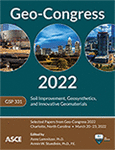Electro-Osmosis Dewatering and Consolidation—G-I China Scan Tour Overview
Publication: Geo-Congress 2022
ABSTRACT
As one of the electrokinetic phenomena, electro-osmosis has been used since 1970s as a soil improvement method to assist dewatering from soil, especially soft clay. The application of electro-osmosis for dewatering or consolidation involves installing anodes and cathodes, which induces directed water movement toward cathode. Over the past decade, due to the invention of different conductive materials, the electrodes can now be made from polymer; as a result, the electrodes can be made into the form of Prefabricated Vertical Drains (PVDs) to serve dual functions. Such development facilitated the wider adoption of electro-osmosis to treat clay soil. G-I sponsored Soil Improvement Committee a scan tour in China in 2018. A large land reclamation project in Taizhou, China, was visited during that scan tour. The soil at the site consisted of 3–4 m of dredging fill that was underlain by approximately 20 m of peat. The reclaimed land will be used for warehouse, roads, and office buildings. The estimated post-construction settlement would be in the magnitude of meters if soil was not treated before construction. Multiple soil improvement methods were utilized to drain the water from dredging soil and peat, among which electro-osmosis was used in one test section. Totally, two hundred electrodes were installed in the sections and connected to DC power. The electric current was monitored and adjusted in real time by a central control unit to ensure a good progress of the dewatering. During our site visit, the measured settlements was in a ranged from 500 to 750 mm, 32 days since the start of electro-osmosis dewatering/consolidation. The settlement values were significantly higher than these obtained from the neighboring sections with conventional vacuum preloading to consolidate the clay. The average energy consumption of the electro-osmosis ranged from 4 to 7 kwh/m3 for the project. The project indicates that the electro-osmosis has great potential to treat clay with the newly developed polymeric electrodes.
Get full access to this article
View all available purchase options and get full access to this chapter.
REFERENCES
Dukhin, S. S., and Derjaguin, B. V. (1974). Electrokinetic Phenomena, J. Willey and Sons.
Esrig, M. I. (1968). “Pore pressure, consolidation and electrokinetics.” Journal of the SMFD, 94(SM4), 899–921.
Hamir, R. B., Jones, C. J. F. P., and Clarke, B. G. (2001). “Electrically conductive geosynthetics for consolidation and reinforced soil.” Geotextiles and Geomembranes, 19, 455–482.
Helmholtz, H. (1879). “Studien über electrische grenzschichten.” Annalen der Physik, 243(7), 337–496.
Hunter, R. J. (1989). Foundations of Colloid Science, Oxford University Press.
Jones, C. J. F. P. (1996). Earth Reinforcement and Soil Structures, Thomas Telford, London.
Jones, C. J. F. P., Lamont-Black, J., and Glendinning, S. (2011). “Electrokinetic geosynthetics in hydraulic applications.” Geotextiles and Geomembranes, 29(2011), 381–390.
Lageman, R., Pool, W., and Seffinga, G. A. (1989). “Electro-reclamation: state-of-the-art.” NATO/CCMS 3rd Int. Conf. on Demonstration of Remedial Action Technologies for Contaminated land and GroundwaterMontreal, Canada, 115–136.
Mitchell, J. K. (1991). “Conduction phenomena: from theory to geotechnical practice.” Geotechnique, 41(3), 299–340.
Mitchell, J. K. A. S. K. (2005). Fundamentals of Soil Behavior, John Wiley & Sons.
Moghadam, M. J., Moayedi, H., Sadeghi, M. M., and Hajiannia, A. (2016). “A review of combinations of electrokinetic applications.” Environ Geochem Health 38, 1217–1227.
Nettleton, I. M., Jones, C. J. F. P., Clarke, B. G., and Hamir, R. (1998). “Electrokinetic geosynthetics and their applications.” 6th Int. Conf. on GeosyntheticsAtlant, GA, USA, 871–876.
Reuss, F. F. (1809). “Notice sur un nouvel effect delélectricité galvanique.” Mémoires de la société impériale de naturalists de Moscou, 2, 327–337.
Sun, Z., Yu, X., Gao, M., and Wu, K. (2017). “Experimental studies on vacuum preloading incorporated with electro-osmosis consolidation for dredger fill.” Chinese Journal of Geotechnical Engineering, 39(2), 250–258.
von Smuluchowski, M. (1914). “Eletrische endosmose und strömungsströme.” Handbuch der elektrizität und des magnetismuc band II, lieferung 2, L. L. J. A. B. Graetz, ed., 366–428.
Wang, J., Zhang, L., Liu, F., and Fu, H. (2014). “Experimental study of vacuum preloading combinedreinforcement with electro-osmosis in soft clay ground.” Chinese Journal of Rock Mechanics and Engineering, 33(Supp.2), 4181–4192.
Yao, Z., Li, J., Xie, H., and Yu, C. (2012). “Review on remediation technologies of soil contaminated by heavy metals.” Procedia Environmental Sciences 16, 722–729.
Zhuang, Y., Huang, Y., Liu, F., Zou, W., and Li, Z. (2014). “Case study on hydraulic reclaimed sludge consolidation using electrokinetic geosynthetics.” 10th International Conference on GeosyntheticsBerlin, Germany.
Zhuang, Y. F. (2005). Research On EKG Material and its Application in Slope Reinforcement. Ph.D., Wuhan University, Wuhan.
Zhuang, Y. F. (2016). “Application of novel EKG and electro-osmosis in hydraulically filled sludge dewatering and consolidation.” 6th Asian Regional Conference on Geosynthetics: Geosynthetics for Infrastructure Development.
Zhuang, Y. F. (2021). “Large scale soft ground consolidation using electrokinetic geosynthetics.” Geotextiles and Geomembranes, 49(3), 757–770.
Zhuang, Y. F., Azzam, R., and Klapperich, H. (2015). Electrokinetics in Geotechnical and Environmental Engineering, RWTH Aachen University.
Zhuang, Y. F., and Wang, Z. (2005). “Electric charge accumulation theory for electro-osmotic consolidation.” Rock and Soil Mechanics, 26(4), 629–632.
Zhuang, Y. F., Zou, W. L., Wang, Z., Tan, X., Hu, P., S., H., Yan, Y., and Wang, Y. (2012). Electrically conductive PVD China.
Information & Authors
Information
Published In
History
Published online: Mar 17, 2022
Authors
Metrics & Citations
Metrics
Citations
Download citation
If you have the appropriate software installed, you can download article citation data to the citation manager of your choice. Simply select your manager software from the list below and click Download.
